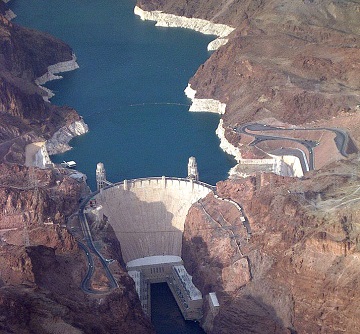Hydroelectric reservoir

A hydroelectric reservoir is a large collection of water behind a hydroelectric dam that makes use of potential energy of water for generating electricity.This water is held back by the dam, and is allowed to fall to generate electricity when it is needed.[2] These reservoirs are one type of water storage that is especially important to hydroelectricity.
Function
The water held in the reservoir of a hydroelectric facility is at a higher elevation than the rest of the dam. The height that this water is at is known as the hydraulic head, and is one of the major factors in determining how much electricity can be generated. This is because the water, held at a higher level, has a certain amount of potential energy that is converted to the rotational motion of turbines as it falls and spins the turbines blades. The higher the water is, the more potential energy it has and thus the more electricity can be generated. As well, the fact that this water is held up in a reservoir means that it moves down the dam through the penstocks effortlessly when gates are opened. This allows the amount of electricity being produced to vary quickly based on demand.[3]
In addition to the water being held much higher than components of the dam such as the turbines, the water held in the reservoir is higher than the natural height of the water flowing in the river.
Environmental Effects
Although necessary for large-scale hydro projects (reservoirs and other water storage methods are not used in run-of-the-river systems) the creation of reservoirs can have negative environmental effects. The transformation of the river upstream of a dam into an artificial reservoir drastically changes the habitat of aquatic organisms. In this reservoir there are changes in water temperature, chemical composition, and reduced oxygen levels (known as hypoxic conditions) which lead to environments unsuitable for aquatic life that previously inhabited the river ecosystem. Most reservoirs host non-native and invasive species such as algae and snails, harming the ecosystem further.[4]
Additionally, land that is covered when a reservoir forms contributes to greenhouse gas emissions, primarily methane. When previously uncovered land is transformed into a reservoir environment, organic matter from vegetation rots, producing methane. These greenhouse gas emissions are harmful to the environment, contributing to climate change.[5] These emissions do tend to be lower than from the combustion of fossil fuels though.
References
- ↑ Wikimedia Commons. (September 1, 2015). Hoover Dam [Online]. Available: https://upload.wikimedia.org/wikipedia/commons/d/d8/Hoover_Dam_Nevada_Luftaufnahme.jpg
- ↑ Quebec Hydro. (September 1, 2015). Reservoirs [Online]. Available: http://www.hydroquebec.com/learning/hydroelectricite/gestion-eau.html
- ↑ BrightHub Engineering. (September 1, 2015). The Components of Hydroelectric Power Plants [Online]. Available: http://www.brighthubengineering.com/fluid-mechanics-hydraulics/7120-components-of-hydroelectric-power-plants-part-one/?cid=parsely_rec
- ↑ International Rivers. (September 1, 2015). Environmental Impacts of Dams [Online]. Available: http://www.internationalrivers.org/environmental-impacts-of-dams
- ↑ International Rivers. (September 1, 2015). Reservoir Emissions [Online]. Available: http://www.internationalrivers.org/campaigns/reservoir-emissions

